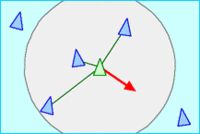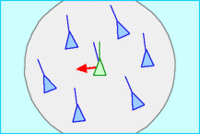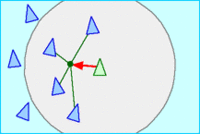“鸟群算法”的版本间的差异
| 第396行: | 第396行: | ||
| − | + | 在当时提出时,雷诺兹的方法相比于传统的计算机动画电影技术是一个巨大的进步。第一部利用了此模型的动画片是《'''史丹利和史黛拉: 破冰 Stanley and Stella in: Breaking The Ice'''》(1987),之后是'''蒂姆·伯顿 Tim Burton'''的故事片《'''蝙蝠侠归来 Batman Returns'''》(1992),电脑合成的蝙蝠群和成群的企鹅行进穿过'''哥谭市 Gotham City'''的街道。 | |
| 第626行: | 第626行: | ||
生命如何起源,智能如何涌现,因果如何反转,复杂谜题,引人深思。2019年7月13日,集智俱乐部创始人[[张江]]教授在混沌大学授课,详细解读了复杂系统中的混沌、涌现与进化,此文整理自课堂内容。 | 生命如何起源,智能如何涌现,因果如何反转,复杂谜题,引人深思。2019年7月13日,集智俱乐部创始人[[张江]]教授在混沌大学授课,详细解读了复杂系统中的混沌、涌现与进化,此文整理自课堂内容。 | ||
| − | ==[https://v.qq.com/x/page/z13491sn7fy.html 动画片《Stanley and Stella in: Breaking the Ice (1987)》] | + | ===[https://v.qq.com/x/page/z13491sn7fy.html 动画片《Stanley and Stella in: Breaking the Ice (1987)》]=== |
| + | |||
| + | Craig Reynolds 与 Symbolics Graphics 和 Whitney / Demos Production 的同事合作制作的利用 boids 模型的小短片,讲述了飞鸟与鱼相爱,鸟儿冲破冰面与鱼相见的故事。影片最早于87年在 SIGGRAPH 电子剧院展出。 | ||
| + | |||
| + | --[[用户:Dorr|Dorr]]([[用户讨论:Dorr|讨论]])补充自http://www.red3d.com/cwr/boids/:In cooperation with many coworkers at the Symbolics Graphics Division and Whitney / Demos Productions, we made an animated short featuring the boids model called Stanley and Stella in: Breaking the Ice. This film was first shown at the Electronic Theater at SIGGRAPH '87. | ||
[[Category:Artificial life]] | [[Category:Artificial life]] | ||
2020年7月19日 (日) 21:26的版本
此词条暂由彩云小译翻译,未经人工整理和审校,带来阅读不便,请见谅。
A Boids example created in OpenGL
在[[[ OpenGL ]]中创建的 Boids 示例
Boids is an artificial life program, developed by Craig Reynolds in 1986, which simulates the flocking behaviour of birds. His paper on this topic was published in 1987 in the proceedings of the ACM SIGGRAPH conference. 引用错误:没有找到与</ref>对应的<ref>标签
}}</ref>
{} / ref
The name "boid" corresponds to a shortened version of "bird-oid object", which refers to a bird-like object.引用错误:没有找到与</ref>对应的<ref>标签 Incidentally, "boid" is also a New York Metropolitan dialect pronunciation for "bird".
}}</ref> Incidentally, "boid" is also a New York Metropolitan dialect pronunciation for "bird".
} / ref 鸟群算法 Boids是模拟鸟类群集行为的人工生命项目,由克雷格·雷诺兹 Craig Reynolds于1986年开发。该模型基于常用于计算机动画或计算机辅助设计的计算机三维几何。他关于这个主题的论文发表在1987年的 ACM SIGGRAPH(美国计算机协会计算机图形专业组组织的计算机图形学顶级年度会议)会议记录上。“ boid”是“ bird-oid object”的缩写,指一个类鸟对象。恰巧,“boid”也是纽约都市方言中“bird”的发音。
--Dorr(讨论)补充自http://www.red3d.com/cwr/boids/:It was based on three dimensional computational geometry of the sort normally used in computer animation or computer aided design.
页面模板:Multiple image/styles.css没有内容。
As with most artificial life simulations, Boids is an example of emergent behavior; that is, the complexity of Boids arises from the interaction of individual agents (the boids, in this case) adhering to a set of simple rules. The rules applied in the simplest Boids world are as follows:
As with most artificial life simulations, Boids is an example of emergent behavior; that is, the complexity of Boids arises from the interaction of individual agents (the boids, in this case) adhering to a set of simple rules. The rules applied in the simplest Boids world are as follows:
与大多数人工生命模拟一样,Boids 是涌现 Emergent行为的一个例子; 也就是说,Boids 的复杂性来自于遵循一系列简单规则的个体代理(这里是 Boids)的相互作用。在最简单的Bolds 世界中适用的规则如下,其描述了鸟群中的个体如何根据周边同伴的位置和速度移动:
- separation: steer to avoid crowding local flockmates
- alignment: steer towards the average heading of local flockmates
- cohesion: steer to move towards the average position (center of mass) of local flockmates
- 分离 Separation: 移动以避开群体拥挤处
- 对齐 Alignment: 转向群体的平均航向
- 靠近 Cohesion: 朝群体的平均位置(质心)移动
每个 boid 个体都可以得知整体的几何参数,但群体要求其只对其周围某个小邻近范围作出反应。该邻近范围由一个距离(从该个体的中心算起)和一个角度(从其飞行方向算起)决定。此范围外的同伴不予考虑。该临近范围可以认为是一个有限知觉的模型(就像浑浊的水中的鱼一样);但更恰当的想法可能是,其定义了鸟群影响了个体转向的区域范围。
--Dorr(讨论)补充自http://www.red3d.com/cwr/boids/:Each boid has direct access to the whole scene's geometric description, but flocking requires that it reacts only to flockmates within a certain small neighborhood around itself. The neighborhood is characterized by a distance (measured from the center of the boid) and an angle, measured from the boid's direction of flight. Flockmates outside this local neighborhood are ignored. The neighborhood could be considered a model of limited perception (as by fish in murky water) but it is probably more correct to think of it as defining the region in which flockmates influence a boids steering.
More complex rules can be added, such as obstacle avoidance and goal seeking.
More complex rules can be added, such as obstacle avoidance and goal seeking.
可以添加更复杂的规则,如避障和寻找目标。
The basic model has been extended in several different ways since Reynolds proposed it. For instance, Delgado-Mata et al.引用错误:没有找到与</ref>对应的<ref>标签
|doi= 10.1007/s00354-007-0009-5}}</ref>
| doi 10.1007 / s00354-007-0009-5} / ref
extended the basic model to incorporate the effects of fear. Olfaction was used to transmit emotion between animals, through pheromones modelled as particles in a free expansion gas. Hartman and Benes引用错误:没有找到与</ref>对应的<ref>标签
|doi= 10.1002/cav.123}}</ref>
10.1002 / cav. 123} / ref
introduced a complementary force to the alignment that they call the change of leadership. This steer defines the chance of the boid to become a leader and try to escape.
introduced a complementary force to the alignment that they call the change of leadership. This steer defines the chance of the boid to become a leader and try to escape.
该基本模型自雷诺兹提出以来,已用多种方法扩展。例如,Delgado-Mata 等人扩展基本模型以加入恐惧的影响。利过一种可用自由膨胀气体中的粒子模拟的信息素,动物间用嗅觉来传递情感。哈特曼 Hartman和贝内斯 Benes为定位过程引入了一种补充力量,他们称之为领导权的更迭。这条决定了某只鸟成为领导者及试图逃跑的机会。
The movement of Boids can be characterized as either chaotic (splitting groups and wild behaviour) or orderly. Unexpected behaviours, such as splitting flocks and reuniting after avoiding obstacles, can be considered emergent.
The movement of Boids can be characterized as either chaotic (splitting groups and wild behaviour) or orderly. Unexpected behaviours, such as splitting flocks and reuniting after avoiding obstacles, can be considered emergent.
Boids 的运动可以表现为混乱(分裂的群体和狂野的行为)或有序。意想不到的行为,比如群体分散和避开障碍后的团聚可以被认为是应急的。
The boids framework is often used in computer graphics, providing realistic-looking representations of flocks of birds and other creatures, such as schools of fish or herds of animals. It was for instance used in the 1998 video game Half-Life for the flying bird-like creatures seen at the end of the game on Xen, named "boid" in the game files.
The boids framework is often used in computer graphics, providing realistic-looking representations of flocks of birds and other creatures, such as schools of fish or herds of animals. It was for instance used in the 1998 video game Half-Life for the flying bird-like creatures seen at the end of the game on Xen, named "boid" in the game files.
Boids 框架通常用于计算机图形学,提供鸟群和其他生物(如鱼群)的逼真表现。例如,在1998年的视频游戏《半条命 Half-Life》中,Xen(游戏文件中命名为“ boid”)中游戏结束时出现的类似鸟类的飞行生物就使用了该框架。
--Dorr(讨论)存疑
The Boids model can be used for direct control and stabilization of teams of simple Unmanned Ground Vehicles (UGV)[1] or Micro Aerial Vehicles (MAV)[2] in swarm robotics. For stabilization of heterogeneous UAV-UGV teams, the model was adapted for using onboard relative localization by Saska et al.[3]
The Boids model can be used for direct control and stabilization of teams of simple Unmanned Ground Vehicles (UGV) or Micro Aerial Vehicles (MAV) in swarm robotics. For stabilization of heterogeneous UAV-UGV teams, the model was adapted for using onboard relative localization by Saska et al.
Boids 模型可用于集群机器人 Swarm Robotics中简单的无人地面车辆(UGV)或微型飞行器 Micro Aerial Vehicles(MAV)群体的直接控制和稳定。为了稳定异质 UAV-UGV 团队,Saska 等人将该模型用于板载相对定位。
At the time of proposal, Reynolds' approach represented a giant step forward compared to the traditional techniques used in computer animation for motion pictures. The first animation created with the model was Stanley and Stella in: Breaking the Ice (1987), followed by a feature film debut in Tim Burton's film Batman Returns (1992) with computer generated bat swarms and armies of penguins marching through the streets of Gotham City.[4]
At the time of proposal, Reynolds' approach represented a giant step forward compared to the traditional techniques used in computer animation for motion pictures. The first animation created with the model was Stanley and Stella in: Breaking the Ice (1987), followed by a feature film debut in Tim Burton's film Batman Returns (1992) with computer generated bat swarms and armies of penguins marching through the streets of Gotham City.
在当时提出时,雷诺兹的方法相比于传统的计算机动画电影技术是一个巨大的进步。第一部利用了此模型的动画片是《史丹利和史黛拉: 破冰 Stanley and Stella in: Breaking The Ice》(1987),之后是蒂姆·伯顿 Tim Burton的故事片《蝙蝠侠归来 Batman Returns》(1992),电脑合成的蝙蝠群和成群的企鹅行进穿过哥谭市 Gotham City的街道。
The boids model has been used for other interesting applications. It has been applied to automatically program Internet multi-channel radio stations.引用错误:没有找到与</ref>对应的<ref>标签
}}</ref>
{} / ref
It has also been used for visualizing information引用错误:没有找到与</ref>对应的<ref>标签
}}</ref>
{} / ref
and for optimization tasks.引用错误:没有找到与</ref>对应的<ref>标签
|doi= 10.1504/IJICA.2009.031778}}</ref>
| doi 10.1504 / IJICA. 2009.031778} / ref
Boids 模型已经被用于其他有趣应用。该系统已应用于互联网多频道广播电台的自动节目编排,以及可视化信息和优化任务。
See also 参见
- Swarm intelligence 群体智能
- Collective cell migration 集体细胞迁移
References 参考资料
- ↑ Min, Hongkyu; Wang, Zhidong (2011). Design and analysis of Group Escape Behavior for distributed autonomous mobile robots. IEEE International Conference on Robotics and Automation (ICRA). doi:10.1109/ICRA.2011.5980123.
- ↑ Saska, Martin; Jan, Vakula; Libor, Preucil (2014). Swarms of micro aerial vehicles stabilized under a visual relative localization. IEEE International Conference on Robotics and Automation (ICRA). doi:10.1109/ICRA.2014.6907374.
- ↑ Saska, Martin; Vojtech, Vonasek; Tomas, Krajnik; Libor, Preucil (2012). Coordination and Navigation of Heterogeneous UAVs-UGVs Teams Localized by a Hawk-Eye Approach (PDF). IEEE/RSJ International Conference on Intelligent Robots and Systems (IROS).
- ↑ Lebar Bajec, Iztok; Heppner, Frank H. (2009). "Organized flight in birds" (PDF). Animal Behaviour. 78 (4): 777–789. doi:10.1016/j.anbehav.2009.07.007.
External links 外部链接
- Live In-Browser 3D Simulation of Bird Flocking Behavior in Unity3D – Open Source implementation for Windows, Linux and Mac
- GLSchool - part of XScreenSaver software
模板:Collective animal behaviour
编者推荐
集智学园课程:透过人工鸟群Boid模型学习List的使用
讲师:张江(北师大系统科学学院教授、博士生导师,集智俱乐部、集智学园创始人。)
本课程通过数个案例教会大家如何去动手搭建一个多主体仿真模型,以及如何利用NetLogo去实现。从生命游戏到人工鸟群,从模拟经济系统到病毒沿网络的传播,通过循序渐进的案例,该课程带你逐步走入NetLogo多主体建模的神奇世界。
集智俱乐部扩展阅读:张江:乌合之众还是群智涌现?鸟群知道答案
生命如何起源,智能如何涌现,因果如何反转,复杂谜题,引人深思。2019年7月13日,集智俱乐部创始人张江教授在混沌大学授课,详细解读了复杂系统中的混沌、涌现与进化,此文整理自课堂内容。
动画片《Stanley and Stella in: Breaking the Ice (1987)》
Craig Reynolds 与 Symbolics Graphics 和 Whitney / Demos Production 的同事合作制作的利用 boids 模型的小短片,讲述了飞鸟与鱼相爱,鸟儿冲破冰面与鱼相见的故事。影片最早于87年在 SIGGRAPH 电子剧院展出。
--Dorr(讨论)补充自http://www.red3d.com/cwr/boids/:In cooperation with many coworkers at the Symbolics Graphics Division and Whitney / Demos Productions, we made an animated short featuring the boids model called Stanley and Stella in: Breaking the Ice. This film was first shown at the Electronic Theater at SIGGRAPH '87.
Category:Artificial life
类别: 人工生命
Category:1986 software
类别: 1986软件
This page was moved from wikipedia:en:Boids. Its edit history can be viewed at 鸟群算法/edithistory


